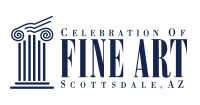Mixed media collage artist Aileen Frick took an interest in art at a young age, but the rigors of high school academics pulled her away from creative endeavors and led her to a career in engineering.
It wasn’t until a friend asked her to take a painting class after work that Aileen rediscovered her talent for art. She continued to take art classes, and when a beloved teacher introduced her to mixed media collage, she knew she had found her medium.
Hear more from Aileen about how her skill and passion propelled her into a second career as an artist.
What was your first introduction to art?
I think I’ve been doing it ever since I was born, ever since I remember. I used to love to draw and sketch as a little kid. Everybody would be doing their own things, and I’d just sit there with my mom’s Spiegel catalog and draw the models. I just loved to draw.
So I did, and he was really instrumental in guiding what I would go on to become: an artist. It’s just incredible to me, the impact a teacher can have on a student. That’s where it all started.
How did that spark turn into a passion?
I did art as a kid through classes all throughout grade school. Then when we went to high school, it was all math and science. Then, like every good artist, I went into engineering.
I moved out to Arizona, and had a friend who said, “Hey, why don’t we take a painting class?” So, I signed up for a painting class —— I thought it’d be fun instead of going to happy hour. We took the first class, and the very first painting I did turned out amazing. I didn’t know I had it in me. I knew I could draw. It’s a hobby I’ve always had, but I didn’t know I could paint
How did you get started in mixed media collage?
I had a teacher who I just loved. She was super encouraging, very positive. It was an oil painting class and she brought in paper one day and said, “We’re going to collage.” And my first piece she saw that I did in paper, she said, “This is your thing. Put a body of work together, go to a gallery.” Being a full-time engineer at the time, I had no idea what she meant She explained, “You just need to start showing your work, and then put a collection together.”
And so I did. I showed at the First Fridays in Phoenix. That spawned into people looking at my work saying, “You don’t belong here on the street. You know, you’re a step above.” And then I did my first festival, and the people that ran that show said, “What are you doing here? You belong at a different level. Have you heard of this?” And galleries started coming, and it just blew up from there.
What is most challenging about your process?
The challenge is time. My work is very involved with the paper —— looking through magazines, trying to find the right colors, trying to find patterns, tearing and gluing all the individual little pieces.
It’s very time-consuming, but it’s very profound at the same time. I find with a lot of my pieces, I know what I’m creating [in terms of] the overall image, but I don’t know what the story is. The story unfolds as I’m working, or sometimes years later, I don’t know what the story is. I don’t know what the words mean. I’m not reading them. It’s intuitive. Everything about the piece is very intuitive for me. I’m working on a level that is subconscious.
What makes the Celebration of Fine Art unique?
The show is amazing because of the connection with other artists —— just that space of learning and encouraging and growing and being supportive of each other. Also, meeting the collectors. At a festival, it’s so fast-paced, you don’t have time to talk with clients, so it’s [Celebration of Fine Art] really unique in that regard. You can really find out what your buyer is looking for and make that personal connection and learn about their lives.

